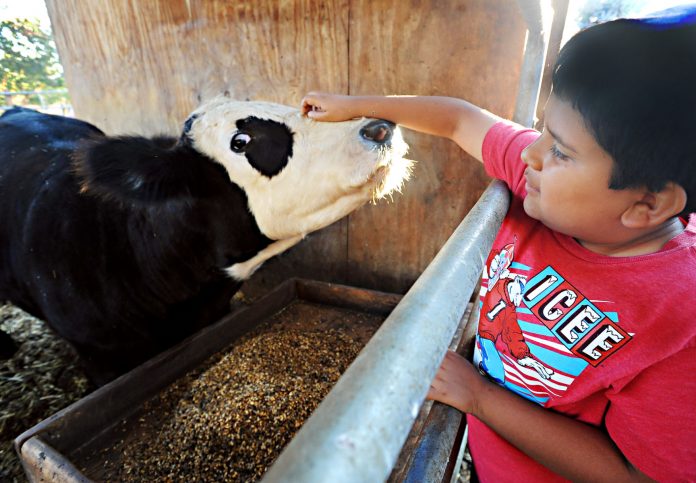
Hollister resident Daniel Pulido, 10, pulls on the rope halter for his more than 1,350-pound steer, stops, focuses his energy and pulls again as he leads the bovine through a four-acre apricot orchard.
Leading a steer around the trees is something his older brother, San Benito High School senior, Martin, and his sister, San Benito High School sophomore, Isabella, started doing years ago.
But this year is the first all three Pulido siblings are preparing their own steers for show at the San Benito County Fair, which runs Oct. 3,4 and 5 and boasts the theme “pigs, pies and paintings” – or in the case of this brother and sister trio: steers.
“I think steers are more of a challenge in that they take more time than any other animal,” says Isabella, 15, who participates in her high school’s chapter of the Future Farmers of America, a national agriculture leadership organization for youth.
Isabella and her brother, Daniel, are showing “homegrown steers” – which means the animals were bred, born and fed in San Benito County. In this case, the two steers came right from the family’s own small herd of beef cattle.
The money Isabella earns from the sale of her steer “Charlie” will go toward helping her buy another animal next year and at the end of her years of showing will pay some of her bills for college. Isabella is hoping to become a large-animal veterinarian, so that one day she can do the necessary procedures to keep her family’s growing herd of beef cattle healthy and strong.
College is still a few years out, so for now, Isabella is busy waking up early and making the 12 minute car trip out to the orchard to feed her steer before school starts. Each afternoon, she dons boots and jeans and feeds him a second serving of finisher grain, as he eats a total of 21 pounds of feed each day.
Isabella is hoping that when she takes her steer – who weighed 1,250 pounds about a month ago – to fair in a week, he’ll weigh at least 1,375 pounds and will sell for $3 to $5 a pound. The fair asks livestock buyers to pay per pound up to a maximum of 1,375 pounds. Isabella wants him to take home the “Breeder Showcase” title, an award that recognizes the best animal bred, born and fed in the county this year.
Every day, she washes her steer and practices walking him in circles and posing him for an imaginary judge, or sometimes her dad.
And it’s this hard work that keeps her parents, Mark and Jeannette Pulido, supporting their children in this hands-on hobby that ties them into the circles of life and death as their children raise calves that sometimes make it and sometimes don’t.
“Here, they’re taking an animal and putting time and effort into it and they get a final product for market,” Jeannette says. “It keeps them out of trouble.”
When Martin came home from a regular day of work at Sabor Farms – which is based in Salinas – on Sept. 19, he immediately went out to see his steer in the fading light.
Now in his ninth and final year of showing, Martin has kept the ear tags of every steer he’s owned. He nails the ear tags to a fence post when he takes out the one the animal got from its breeder and replaces it with the tag assigned by the fair.
This Friday, it’s time to add the ear tags from two of the steers to the fence post and to reflect on why he devotes so much time to the project.
“I like the outcome,” he says. “I like seeing how something small becomes something big.”
The county fair only requires competitors to own their steers 120 days before the show, but since the Pulidos try to raise their own animals they see them from the time they’re born to days before slaughter. The amount of time competitors must own their steers is double the requirement for most other animals at the fair – including goats, pigs and lambs – making it one of the most labor intensive animal projects a youth can bring to the fair.
“It’s very rewarding,” Jeannette says. “I know it’s harder for them because you see them born as calves.”
This year the Pulidos bred two of their own animals – Daniel’s steer and Isabella’s animal – and purchased one more for Martin because they didn’t have enough male calves born to their herd this year.
“It’s hard,” Daniel says, as he thinks about the process of preparing his first steer for the show. “Because you have to do it every week, every day, every month until it’s sold.”
Nearby, Jeannette watches her children and the steers. She’s already thinking about the day when Daniel becomes too old to show, but she’s got her eyes on a great-nephew who is 6 years old and one day might take an interest in the beef cattle her children love to raise.
“Hopefully, he’ll show steers,” she says. “And hopefully, Bella and Martin and Daniel will breed a steer that he can show.”









